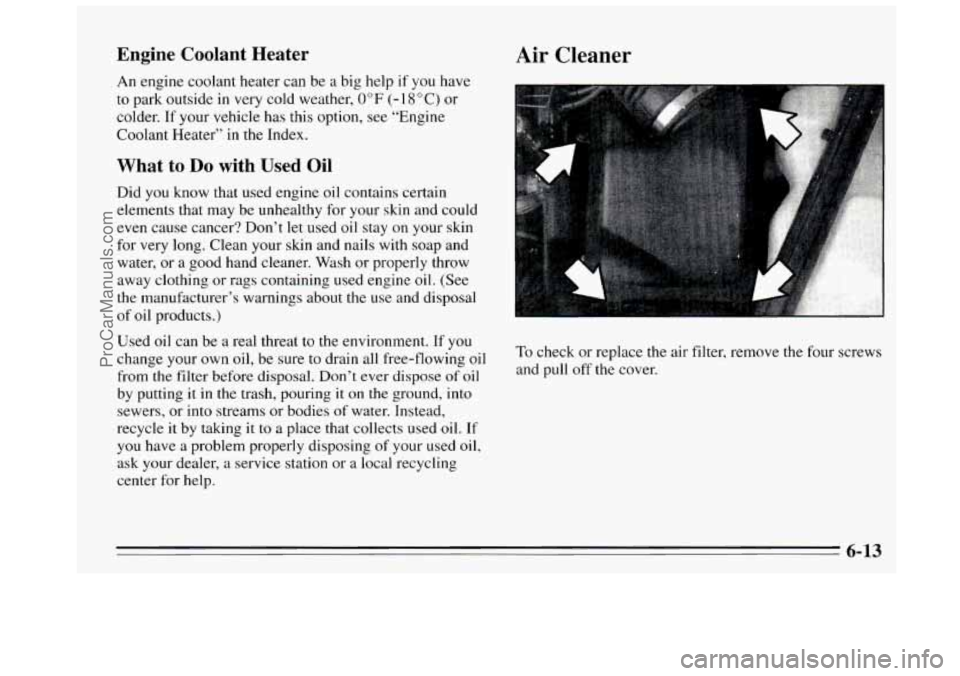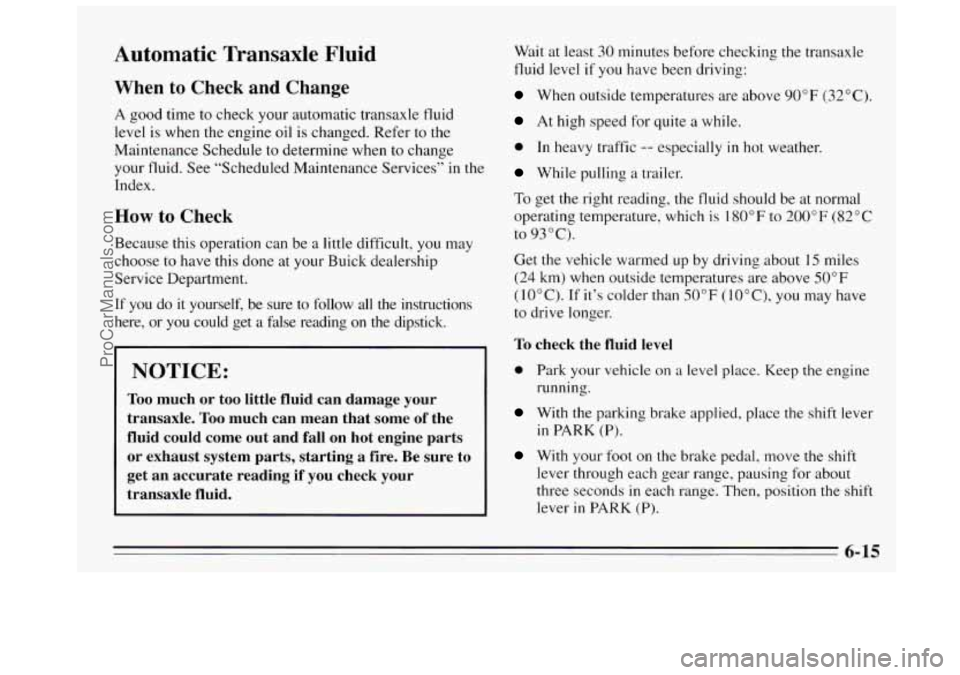Page 207 of 340

If You’re Stuck: In Sand, Mud, Ice or
Snow
What you don’t want to do when your vehicle is stuck is
to spin your wheels too hst. The method known as
“rocking” can help you get out when you’re stuck, but
you must use caution.
A CAUTION:
If you let your tires spin at high speed, they can
explode and you or others could be injured. And,
the transaxle or other parts of the vehicle can
overheat. That could cause an engine
compartment fire or other damage. When you’re
stuck, spin the wheels
as little as possible. Don’t
spin the wheels above
35 mph (55 kdh) as shown
on the speedometer.
NOTICE:
Spinning your wheels can destroy parts of your
vehicle as well as the tires. If you spin the wheels
too fast while shifting your transaxle back and
forth, you can destroy your transaxle.
For information about using tire chains on your vehicle,
see “Tire Chains”
in the Index.
Rocking your vehicle to get it out:
1 First, turn your steering wheel left and right. That will
clear the area around
your front wheels. Then shift back
and forth between
REVERSE (R) and a forward gear,
spinning the wheels as little
as possible. Release the
accelerator pedal while you shift, and press lightly
on
the accelerator pedal when the transaxle is in gear. If
that doesn’t get you out after a few tries, you may need
to be towed
out. If you do need to be towed out, see
“Towing Your Vehicle”
in the Index.
- 5-33
ProCarManuals.com
Page 210 of 340
Doing Your Own Service Work
If you want to do some of your own service work, you’ll
want to get the proper Buick Service Manual.
It tells you
much more about how to service your Buick than this
manual can. To order the proper service manual, see
“Service Publications”
in the Index.
Your vehicle has an air
bag system. Before attempting to
do your own service work, see “Servicing Your Air
Bag-Equipped Buick” in the Index.
You should keep
a record with all parts receipts and
list the mileage and the date
of any service work you
perform. See “Maintenance Record”
in the Index.
NOTICE:
If you try to do your own service work without
knowing enough about it,
your vehicle could be
damaged.
6-2
ProCarManuals.com
Page 214 of 340
Be careful not to spill gasoline. Clean gasoline from
painted surfaces as soon as possible. See “Cleaning the
Outside
of Your Buick” in the Index.
When you put the cap back on, turn it to the right until
you hear at least
three clicks.
L
NOTICE:
If you need a new cap, be sure to get the right
type. Your dealer can get one for you.
If you get
the wrong type, it may not fit or have proper
venting, and your fuel tank and emissions system
might be damaged.
Checking Things Under the Hood
1
6-6 I
ProCarManuals.com
Page 215 of 340
Hood Release
To open the hood, first pull
the handle inside the
vehicle.
Then go to
the front of the
vehicle and release the
secondary hood release. Lift
the hood. Before closing the
hood, be sure
all the filler caps are on
properly. Then just pull the
firmly.
Engine Oil
hood down and close it
If the LOW OIL LEVEL
light on the instrument
panel comes on, it means
you need to check your
engine oil level right away.
For more information, see
“Low Oil Level Light” in
the Index.
You should check your engine oil level regularly; this is
an added reminder.
It’s
a good idea to check your engine oil every time you
get fuel. In order to get an accurate reading, the oil must
be warm and the vehicle must be on level ground.
6-7
ProCarManuals.com
Page 217 of 340
When to Add Oil
If the oil is at or below the ADD mark, then you’ll need
to add some oil. But you must use the right kind. This
part explains what kind
of oil to use. For crankcase
capacity, see “Capacities and Specifications” in the
Index.
NOTICE:
Don’t add too much oil. If your engine has
so much oil that the oil level gets above the
cross-hatched area that shows the proper
operating range, your engine could be damaged. 3.1L L82 (Code M) Engine 3.8L L27 (Code L) Engine
Just
fill it enough to put the level somewhere in the
proper operating range. Push the dipstick all the way
back
in when you’re through.
6-9
ProCarManuals.com
Page 221 of 340

Engine Coolant Heater
An engine coolant heater can be a big help if you have
to park outside in very cold weather,
0 OF (- 1 8 O C) or
colder. If your vehicle has this option, see “Engine
Coolant Heater” in
the Index.
What to Do with Used Oil
Did you know that used engine oil contains certain
elements that may be unhealthy for your skin and could
even cause cancer? Don’t
let used oil stay on your skin
for very long. Clean your skin and nails with soap and
water, or a good hand cleaner. Wash or properly throw
away clothing
or rags containing used engine oil. (See
the manufacturer’s warnings about the use and disposal
of oil products.)
Used oil can be a real threat
to the environment. If you
change your own oil, be sure to drain all free-flowing oil
from
the filter before disposal. Don’t ever dispose of oil
by putting it in the trash, pouring it on the ground, into
sewers, or into streams or bodies
of water. Instead,
recycle it by taking
it to a place that collects used oil. if
you have a problem properly disposing of your used oil,
ask your dealer, a service station or a local recycling
center for help.
Air Cleaner
To check or replace the air filter, remove the four screws
and pull off the cover.
6-13
ProCarManuals.com
Page 222 of 340
Pull out the filter. Be sure to install the air filter and
install the cover tightly when you are finished.
Refer to the Maintenance Schedule to determine when to
replace the
air filter.
See “Scheduled Maintenance Services” in the Index.
NOTICE:
If the air cleaner is off, a backfire can cause a
damaging engine fire. And, dirt can easily get
into your engine, which will damage it. Always
have the air cleaner in place when you’re driving.
6-14
ProCarManuals.com
Page 223 of 340

Automatic Transaxle Fluid
When to Check and Change
A good time to check your automatic transaxle fluid
level is when the engine oil is changed. Refer to the
Maintenance Schedule
to determine when to change
your fluid. See “Scheduled Maintenance Services” in
the
Index.
How to Check
Because this operation can be a little difficult, you may
choose to have this done at your Buick dealership
Service Department.
If you do it yourself, be sure
to follow all the instructions
here, or you could get
a false reading on the dipstick.
NOTICE:
Too much or too little fluid can damage your
transaxle.
Too much can mean that some of the
fluid could come out and fall on hot engine parts or exhaust system parts, starting a fire. Be sure to
get an accurate reading if you check your
transaxle fluid.
Wait at least 30 minutes before checking the transaxle
fluid level
if you have been driving:
When outside temperatures are above 90°F (32°C).
At high speed for quite a while.
0 In heavy traffic -- especially in hot weather.
While pulling a trailer.
To get the right reading, the fluid should be at normal
operating temperature, which is
180°F to 200°F (82°C
to
93 ” C).
Get the vehicle warmed up by driving about 15 miles
(24
km) when outside temperatures are above 50°F
(10°C). If it’s colder than 50°F (IOOC), you may have
to drive longer.
To check the fluid level
0 Park your vehicle on a level place. Keep the engine
running.
With the parking brake applied, place the shift lever
in PARK (P).
With your foot on the brake pedal, move the shift
lever through each gear range, pausing for about
three seconds
in each range. Then, position the shift
lever
in PARK (P).
6-15
ProCarManuals.com